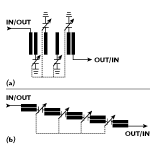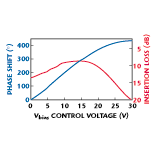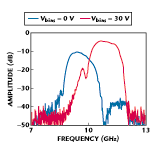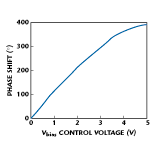Microstrip Resonant Phase Shifters
Matjaz Vidmar
University of Ljubljana
Slovenia
There are several possible designs for adjustable phase shifters (or adjustable delay lines) depending on the operating frequency, required bandwidth, power handling and technology used (mechanical, ferrite, PIN diode, varactor or I/Q modulator). This article describes the particular problem of providing a continuously adjustable delay for the STM64 (OC192)-specified clock frequency of 9.95328 GHz and its integer multiples and submultiples to control different electro-optical devices in optical-fiber line-terminal equipment.
To compensate for (electrical) cable-length tolerances, mechanically stretchable coaxial lines are usually used in optical line-terminal equipment. Since the bandwidth of stretchable coaxial (TEM) lines extends from DC up to the cutoff frequency of other waveguide modes, adjustable coaxial delay lines can be used both for data and clock applications. If the delay must be adjusted frequently while changing some other components in the system or the drifting delay of some electro-optical devices must be compensated automatically, mechanical devices should be replaced, preferably by electrically adjustable delay devices.
Electrically adjustable phase shifters are usually narrowband devices that can be used only to adjust the delays of clock signals. Fortunately, in most electro-optical systems only the relative phase between data and clock is important. Therefore, a practical solution is to feed the data line directly with no adjustable delays while the phases of all required clock signals are made adjustable. One side advantage of this technique is that distortion of the data signal due to reflections is minimized. In addition, some jitter may be removed from the clock signal by narrowband phase-shifting devices.
Electronically controlled phase shifters are usually built with varactors when a continuous phase adjustment is required. The adjustable reflection coefficient of a varactor is transformed into a variable phase shift with a circulator or quadrature hybrid. The quadrature hybrid requires two identical varactors.1 However, the phase shift of available varactors becomes quite limited at microwave frequencies due to chip and package parasitics. Furthermore, varactors are rather lossy capacitors at microwave frequencies. The Q of silicon varactors may be less than 10 at X-band frequencies while GaAs varactors are just slightly better. If chip and package parasitics are tuned out by additional reactive components at a particular frequency, circuit losses due to poor varactor Q will further increase.
Clock phase shifters require a range of at least 360° and some overlap is desired on both ends. Due to the limited phase shift of available varactors, the concatenation of several phase-shifting stages is required. The insertion loss of such a complex circuit as well as insertion loss variation with the varactor control voltage may become considerable. In addition, the microstrip circuit board area may become quite large due to the many quadrature hybrids and reactive components used to tune out varactor parasitics.
Different phase shifter circuits were developed and tested to minimize the circuit board area and number of varactors used. In particular, resonant phase shifters were found to be both simple and efficient. It is possible to build suitable resonant phase shifters for the STM64 clock frequency with a limited number of inexpensive surface-mount device (SMD) plastic-packaged silicon varactors.
The principle of operation of a single-stage resonant phase shifter is straightforward, as shown in Figure 1 . As the circuit is tuned around its resonant frequency, the introduced phase shift is changed. If an amplitude variation of 3 dB is allowed, a phase shift variation of 90° can be obtained. In the case of a microwave phase shifter, all of the resonator components are already present as varactor chip and package parasitics as well as external reactive components used to tune out the parasitics.
straightforward, as shown in Figure 1 . As the circuit is tuned around its resonant frequency, the introduced phase shift is changed. If an amplitude variation of 3 dB is allowed, a phase shift variation of 90° can be obtained. In the case of a microwave phase shifter, all of the resonator components are already present as varactor chip and package parasitics as well as external reactive components used to tune out the parasitics.
To obtain larger phase shifts, several resonators can be concatenated into a multistage resonant phase shifter. A multistage resonant phase shifter can be considered a transmission line with a variable phase velocity. Since the characteristic impedance of the circuit also changes while adjusting the phase shift, additional variable mismatch losses are present only at the circuit’s input and output.
 At microwave frequencies, resonant phase shifters can be built as simple microstrip circuits. Either quarter- or half-wavelength resonators are used, as shown in Figure 2 . In both cases, the microstrip resonators are tuned with series variable capacitors. Since the capacitance of all available varactors is large, varactors are inserted in series at the points of current maxima in the resonators.
At microwave frequencies, resonant phase shifters can be built as simple microstrip circuits. Either quarter- or half-wavelength resonators are used, as shown in Figure 2 . In both cases, the microstrip resonators are tuned with series variable capacitors. Since the capacitance of all available varactors is large, varactors are inserted in series at the points of current maxima in the resonators.
Each of the two solutions has its own advantages and disadvantages. Quarter-wavelength resonators require less printed circuit board area and allow wider coupling gaps between adjacent resonators but require critical connections to ground of the varactors through via holes in the circuit board. On the other hand, half-wavelength resonators do not require any connections to the groundplane on the other side of the printed circuit board, but the narrower coupling gaps require more accurate circuit board etching. Practically speaking, quarter-wavelength resonators are the best solution at lower frequencies, perhaps up to 5 GHz. On the other hand, half-wavelength resonators become practical at frequencies above 5 GHz. Both solutions are presented in this article using practical examples.
A Resonant Microstrip Phase Shifter for 10 GHz
A practical varactor resonant phase shifter for the STM64 (OC192) clock frequency of 9.95328 GHz (sometimes abbreviated to 9.95 GHz or, simply, 10 GHz) can be built with half-wavelength microstrip resonators. Of course, besides the microstrip resonators and varactors, several other microstrip components (quarter-wavelength chokes and printed capacitors) are required to apply the DC bias voltage to all varactors. In addition, SMD resistors are used to suppress unwanted resonances of the bias network, as shown in Figure 3 .
frequency of 9.95328 GHz (sometimes abbreviated to 9.95 GHz or, simply, 10 GHz) can be built with half-wavelength microstrip resonators. Of course, besides the microstrip resonators and varactors, several other microstrip components (quarter-wavelength chokes and printed capacitors) are required to apply the DC bias voltage to all varactors. In addition, SMD resistors are used to suppress unwanted resonances of the bias network, as shown in Figure 3 .
The circuit was first built with BB833 silicon varactors (minimum capacitance of 0.75 pF in an SOD323 SMD package with 2nH lead inductance). Later, the circuit was improved with the new BB857 silicon varactors with 0.55 pF minimum capacitance and an SCD80 SMD package with 0.6 nH lead inductance. Besides a smaller package, the new BB857 varactor also offers an improved Q with respect to the older BB833 device.
According to the manufacturer’s data sheets, both varactors are only intended to be used in satellite television indoor units at frequencies up to 2.8 GHz. At 10 GHz even the BB857 varactor actually behaves as a variable inductor. Its minimum capacitance produces a reactance of –j28.9 W at 10 GHz, while the SCD80 package inductance adds +j37.7 W at 10 GHz. A single BB857 varactor can provide only a limited phase shift at 10 GHz. Therefore, a series connection of nine resonant phase shifting stages is required for a full 360° range phase shifter.
 In order to fully characterize the performance of the described multistage resonant phase shifter, two different microstrip circuit boards were developed and tested, as shown in Figures 4 and 5 . The main difference between both versions is the coupling between adjacent resonators. Version 2 has tighter coupling than version 1, resulting in lower insertion loss, but restricted phase shift variation when
In order to fully characterize the performance of the described multistage resonant phase shifter, two different microstrip circuit boards were developed and tested, as shown in Figures 4 and 5 . The main difference between both versions is the coupling between adjacent resonators. Version 2 has tighter coupling than version 1, resulting in lower insertion loss, but restricted phase shift variation when compared to version 1. Both versions were etched on 0.8-mm-thick (1/32") glass fiber-polytetrafluoroethylene laminate with a dielectric constant of 2.5. The minimum detail size (line or gap width) was set to 0.4 mm to avoid problems with etching tolerances of the 35 mm copper cladding. The size of both printed circuit boards is 40 mm ¥ 80 mm.
compared to version 1. Both versions were etched on 0.8-mm-thick (1/32") glass fiber-polytetrafluoroethylene laminate with a dielectric constant of 2.5. The minimum detail size (line or gap width) was set to 0.4 mm to avoid problems with etching tolerances of the 35 mm copper cladding. The size of both printed circuit boards is 40 mm ¥ 80 mm.
 The performances of both phase shifters are shown in Figures 6 and 7 . Both the phase shift and insertion loss are shown as functions of the control voltage Vbias at the nominal operating frequency of 9.95 GHz. Version 1 has a minimum insertion loss of approximately 9 dB, increasing by approximately 4 to 5 dB for a phase shift coverage of 360°. The overall
The performances of both phase shifters are shown in Figures 6 and 7 . Both the phase shift and insertion loss are shown as functions of the control voltage Vbias at the nominal operating frequency of 9.95 GHz. Version 1 has a minimum insertion loss of approximately 9 dB, increasing by approximately 4 to 5 dB for a phase shift coverage of 360°. The overall available phase shift reaches 430° for a control voltage range of 0 to +30 V. The phase shift range can be further increased by approximately 15° if a small forward bias (negative Vbias) is applied to the varactors. On the other hand, version 2 barely reaches a phase shift coverage of 360° for a control voltage of –1 to +30 V. However, tighter coupling between adjacent resonators allows a reduced minimum insertion loss of less than 6 dB, increasing by only 3 to 4 dB at extreme control voltages. Of course, the insertion loss of both versions can be compensated for by a buffer amplifier. If the amplifier is driven into saturation, it can remove any level variations due to the variable insertion loss of the phase shifter.
available phase shift reaches 430° for a control voltage range of 0 to +30 V. The phase shift range can be further increased by approximately 15° if a small forward bias (negative Vbias) is applied to the varactors. On the other hand, version 2 barely reaches a phase shift coverage of 360° for a control voltage of –1 to +30 V. However, tighter coupling between adjacent resonators allows a reduced minimum insertion loss of less than 6 dB, increasing by only 3 to 4 dB at extreme control voltages. Of course, the insertion loss of both versions can be compensated for by a buffer amplifier. If the amplifier is driven into saturation, it can remove any level variations due to the variable insertion loss of the phase shifter.
 Some further insight into the operation of the described phase shifter an be obtained by
Some further insight into the operation of the described phase shifter an be obtained by characterizing it as a tunable bandpass filter. The amplitude vs. frequency responses of both versions are shown in Figures 8 and 9 for control voltages of 0 and +30 V. Of course, the phase shifter should be used only for frequencies within the filter passband.
characterizing it as a tunable bandpass filter. The amplitude vs. frequency responses of both versions are shown in Figures 8 and 9 for control voltages of 0 and +30 V. Of course, the phase shifter should be used only for frequencies within the filter passband.
Outside the passband the phase variations are small. Even worse, the phase vs. control voltage response becomes rather nonlinear due to parasitic resonances of the bias network and shielded-enclosure cavity. Although linearity was not a requirement in this application, the phase vs. control voltage response should remain monotonic if the phase shifter is used inside an automatic control loop. Therefore, version 1 of the described phase shifter should not be used at frequencies below 9.9 GHz if the full control voltage range of +30 V is allowed.
The data show clearly that the minimum insertion loss of the circuit is inversely proportional to the varactor bias voltage, a function consistent with the fact that the varactor Q increases with the reverse bias voltage.2 Therefore, both versions of the described phase shifter should provide an even larger phase shift variation at slightly higher frequencies (although with a much larger insertion loss variation).
 The total obtainable phase shift vs. frequency is shown in Figure 10 . Both versions provide much more than the required 360° of phase shift variation at higher frequencies. If the control voltage range is restricted to higher voltages, both versions of the phase shifter will still provide an acceptable insertion loss at 10.66 GHz, used as the raw-data clock frequency in STM64 (OC192) systems with forward error correction.
The total obtainable phase shift vs. frequency is shown in Figure 10 . Both versions provide much more than the required 360° of phase shift variation at higher frequencies. If the control voltage range is restricted to higher voltages, both versions of the phase shifter will still provide an acceptable insertion loss at 10.66 GHz, used as the raw-data clock frequency in STM64 (OC192) systems with forward error correction.
A 2.5 GHz Phase Shifter and Multiplier to 10 GHz
Since the early days of analog (voice) frequency and/or phase modulation, frequency multipliers have been used to increase frequency deviation and/or phase shift. Of course, frequency multipliers also can be used at microwave frequencies to simplify the design of microwave phase shifters as described previously.1 At a subharmonic frequency, only a fraction of the total phase shift required at the final frequency needs to be provided. In addition, the effects of chip and package parasitics are smaller and the Qs of available varactors are higher, further simplifying the design of a suitable phase shifter.
In the case of an STM64 clock phase shifter it is convenient to build the varactor phase shifter at one-quarter of the final frequency or 2.48832 GHz. This frequency corresponds to the clock frequency of earlier systems (STM16 or OC48) and is available in multiplexing and demultiplexing as well as various types of test equipment. Since operation at a single clock frequency is required, frequency multiplication by four can be performed by a single nonlinear device followed by a bandpass filter to select the desired harmonic.
 The overall circuit diagram of a 2.5 GHz phase shifter and 4¥ multiplier to 10 GHz is shown in Figure 11 . An input attenuator is used both to isolate the phase shifter from other users of the 2.5 GHz clock and to reduce the input signal level below 1 mW to avoid nonlinear effects in the phase shifter varactors. The phase shifter is constructed as an interdigital filter with quarter-wavelength resonators. Since a phase shift range of only 90° is required, two varactor-tuned
The overall circuit diagram of a 2.5 GHz phase shifter and 4¥ multiplier to 10 GHz is shown in Figure 11 . An input attenuator is used both to isolate the phase shifter from other users of the 2.5 GHz clock and to reduce the input signal level below 1 mW to avoid nonlinear effects in the phase shifter varactors. The phase shifter is constructed as an interdigital filter with quarter-wavelength resonators. Since a phase shift range of only 90° is required, two varactor-tuned resonators are more than sufficient. In particular, low voltage silicon varactors similar to the BBY51-03W are used. Although their capacitance ratio range is rather restricted with the control voltage Vbias between 0 and +5 V, the phase shift range still reaches almost 100° at 2.5 GHz. Figure 12 shows the capacitance vs. voltage characteristics of the BBY51-03W and BB857 varactor diodes.
resonators are more than sufficient. In particular, low voltage silicon varactors similar to the BBY51-03W are used. Although their capacitance ratio range is rather restricted with the control voltage Vbias between 0 and +5 V, the phase shift range still reaches almost 100° at 2.5 GHz. Figure 12 shows the capacitance vs. voltage characteristics of the BBY51-03W and BB857 varactor diodes.
Since the 2.5 GHz signal is further attenuated in the phase shifter, a 2.5 GHz amplifier (ATF35376 high electron mobility transistor (HEMT)) is required to restore the signal level. The HEMT multiplier that follows requires several milliwatts of drive power to efficiently produce harmonics of the input signal. The HEMT multiplier is followed by a 10 GHz bandpass filter with four half-wavelength resonators. Finally, the 10 GHz output signal is further amplified by yet another ATF35376 HEMT to raise the signal level above +5 dBm (usually between +7 and +10 dBm) as required by the clock inputs of the devices used in STM64 line-terminal equipment.
 The 2.5 GHz phase shifter and 4¥ multiplier are built as a microstrip circuit etched on 0.8-mm-thick (1/32") FR-4 glass fiber-epoxy laminate (with a dielectric constant of 4.5). The microstrip circuit board measures 20 mm ¥ 80 mm and is shown in Figure 13 . Although the FR-4 laminate introduces additional losses in the circuit, a lossy substrate prevents high gain devices like the ATF35376 HEMTs from oscillating in the millimeter-wave region.
The 2.5 GHz phase shifter and 4¥ multiplier are built as a microstrip circuit etched on 0.8-mm-thick (1/32") FR-4 glass fiber-epoxy laminate (with a dielectric constant of 4.5). The microstrip circuit board measures 20 mm ¥ 80 mm and is shown in Figure 13 . Although the FR-4 laminate introduces additional losses in the circuit, a lossy substrate prevents high gain devices like the ATF35376 HEMTs from oscillating in the millimeter-wave region.
The performance of the 2.5 GHz phase shifter and multiplier to 10 GHz is shown in Figure 14 . The phase shift range reaches 360° at 9.95 GHz with a control voltage of 0 to +4 V. The amplitude variations of the output signal are very small over the entire control voltage range due to the amplifier and multiplier stages operating close to saturation.
The described 2.5 GHz phase shifter and multiplier to 10 GHz are used as part of an STM64 (OC192) 9.95 Gbps clock recovery unit, as shown in Figure 15 .  The clock recovery unit includes a full-wave rectifier to obtain a clock spectral line from an input nonreturn-to-zero (NRZ) signal and a phase-locked loop (PLL) used as a narrow bandpass filter. The PLL includes a 2.5 GHz VCO driving different multipliers. A frequency doubler to 5 GHz is used to drive two subharmonic mixers in quadrature. The output of the in-phase mixer is used to stop the search logic when the PLL locks. The quadrature mixer then drives the loop amplifier. The search logic allows a very wide capture range (and/or a wide VCO/frequency tolerance) that is independent of the loop bandwidth in the locked state.
The clock recovery unit includes a full-wave rectifier to obtain a clock spectral line from an input nonreturn-to-zero (NRZ) signal and a phase-locked loop (PLL) used as a narrow bandpass filter. The PLL includes a 2.5 GHz VCO driving different multipliers. A frequency doubler to 5 GHz is used to drive two subharmonic mixers in quadrature. The output of the in-phase mixer is used to stop the search logic when the PLL locks. The quadrature mixer then drives the loop amplifier. The search logic allows a very wide capture range (and/or a wide VCO/frequency tolerance) that is independent of the loop bandwidth in the locked state.
The described clock recovery circuit provides several clock outputs. The two 10 GHz outputs have independent phase shifters and multipliers; both can be used as clock sources for different data-processing devices. The additional 2.5 GHz output comes directly from the VCO and has no phase shifter. The 2.5 GHz can be useful in triggering various types of test equipment such as a sampling oscilloscope.
Acknowledgment
The phase shifters and STM64 clock recovery unit described in this article were developed for use in field experiments as part of the European Community Esther ACTS 063 research project. The described circuits were integrated in different optical-fiber transmission experiments at Pirelli Cavi e Sistemi SpA, Milano, Italy. The BB857 and BBY51-03W varactors are manufactured by Siemens Semiconductors, Munich, Germany. The capacitance vs. voltage curves for both varactors are copies taken from the corresponding manufacturers’ data sheets. The ATF35376 HEMTs were manufactured by Avantek (now Hewlett-Packard Co.). The data plots were obtained with an HP8510A vector network analyzer (including an HP8514A S-parameter test set, HP8530B sweep mainframe and HP8A3594A plug-in) and an HP83480A sampling oscilloscope with an HP83482A plug-in.
References
1. David M. Klymyshyn, Surinder Kumar and Abbas Mohammadi, “A 360° Linear Microwave Phase Shifter with a FET Frequency/Phase Multiplier,” Microwave Journal, Vol. 40, No. 7, July 1997, pp. 130–137.
2. Peter Shveshkeyev, “A Wideband VCO for Set-top Applications,” Microwave Journal, Vol. 42, No. 4, April 1999, pp. 74–88.
Matjaz Vidmar received his BSEE and MSEE from the University of Ljubljana, Slovenia in 1980 and 1983, respectively. He received his PhD in 1992, also from the University of Ljubljana, for developing a single-frequency GPS ionospheric correction receiver. Vidmar is currently teaching undergraduate and postgraduate courses in electrical engineering at the University of Ljubljana. His research includes high speed electronics for optical fiber communications. Vidmar is also taking part in amateur satellite projects. He developed very high efficiency VHF and UHF transmitters that were successfully flown in space on the Microsat mission in 1990.
